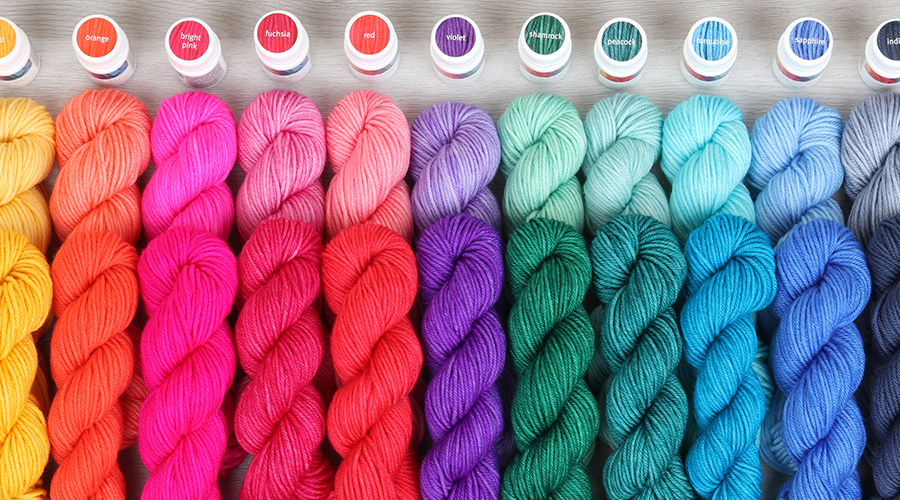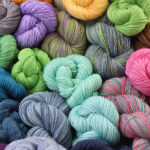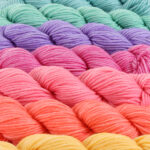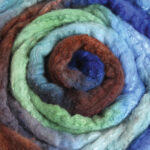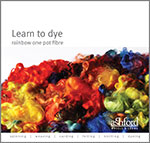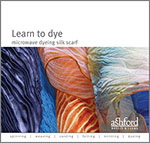
Ashford Protein Dyes
Ashford protein dyes are concentrated (no fillers or salts added) powdered acid exhaust dyes. Dye all protein fibres, yarns and even fabrics or textile material - these dyes are suitable for wool, silk, cashmere, mohair, angora, llama, alpaca, vicuna, feathers and other animal protein fibre or yarn. Our dyes are very easy to use a only require a heat source and white vinegar or citric acid as the mordant (fixative) making them suitable for the home dyer. The dyes are 100% concentrated - only 10gm (¼oz) of dye powder will dye 1kg (2.2lbs) of fibre or yarn making these dyes very economicly. Choose from a variety of dyeing techniques, all resulting in clean, vibrant colours and a wide range of hues.
Stock Solutions
Add 10gm (¼oz) Ashford protein dye powder to ½ cup (125mls, 4oz) of hot water. Stir until dissolved. Add 725mls of cold water.
This will give you 850mls of concentrated 1% dye solution. Most colours will require further dilution. Stock solutions can be stored up to 6 months in a cool, dark cupboard.
Adding the Mordant (fixative)
When you are ready to dye your yarn or fibre, you will need to add vinager or citric acid to the stock solution so the dye fixes to the yarn/fibre. Add 17% (vinegar) of the total amount of solution used. If you are intending on dyeing 1kg of yarn or fibre, using the full 850mls of stock dye solution, add 150mls of vinegar.
If you are dyeing 500gms of yarn or fibre, pour 425mls of stock solution into a bottle, adding 75mls of vinegar.
Some colours, such as bright pink and turquoise may require more mordant to exhaust the colour/dye fully.
Testing/Sampling
For best results it's always important to dye test your fibre or yarn. Different yarns and fibres can uptake the dye differently, if the dye bath isn't exhausting all the way, even if you add more vinegar or citric acid, make a note to use less dye next time for that colour. These are very concentrated dyes.
Exhausting the dye
Exhausting the dye is the transfer of dye/colour from the dye bath to the yarn or fibre. Ashford protein dyes require heat and mordant to exhaust. When the dye has been exhausted, all the colour/dye is absorbed and the water will be clear.
Safety Guidelines
Ashford dyes, if used correctly, are non-hazardous to humans. They are weak acid dyes that are fixed with only common white vinegar and heat. Fibre, yarn and textiles dyed with the Ashford dyes can be worn against the skin without risk. We are in close co-operation with all our suppliers of dyes to ensure they are safe to use and wear. The dyes comply with the strict EU regulations and the manufacturers confirm that cloth dyed with the Ashford dyes can be certified under the Oeko-Tex Standard 100. This standard is the most widely known standard for certification of ecologically-safe clothing. Detailed information can be found under oeko-tex.com/en/our-standards/standard-100-by-oeko-tex. The dyes pose no risk the environment if the dye liquid is neutralised with baking soda before disposal in the waste water system. Full instructions for the safe use and disposal of the dyes are included with the dyes.
Safe Handling Information
- Keep containers tightly closed and out of children’s reach.
- Wear gloves and cover your arms.
- Wear a dust mask when handling dry dye powder or spraying a dye solution.
- Keep dye pots and utensils for dyeing only.
- Avoid breathing fumes.
- Cover all surfaces.
- Ensure all dyes and solutions are labelled.
- Before you dispose of the dye bath liquid, add 1-2 teaspoons of baking soda to the liquid to neutralise the acid in the water.
Health Hazard
Harmful to aquatic organisms, may cause long term adverse effects in the aquatic environment.
First Aid Measures
General Information: Take off immediately all contaminated clothing.
After inhalation: Upon inhalation of aerosol/vapour/dust, take the patient into the fresh air, if there is difficulty breathing, medical advice is required.
After contact with the skin: Cleansing with plenty of water, soap or other non-irritating cleansing agents.
After contact with eyes: Contamination of the eyes must be treated by thorough irrigation with water, with the eyelids held open. Eventually a doctor (or eye specialist) should be consulted.
After ingestion: If the product is swallowed, the patient must at once drink water repeatedly, if possible with the addition of activated carbon. If the patient feels unwell, seek medical advice.
If medical attention is required take the dye and container with you.
Dyeing with Ashford Wool Dyes
Dyeing your yarn or fibre or fabric is easy with Ashford Wool Dyes.
Dye Colour Theory
Learn the basics of colour theory.
Dye Recipes
Click on images to download pdf of dye colour recipes. *Note all the recipes are for 100gm (4oz) of fibre or yarn.*
Subscribe
Subscribe to our YouTube channel for more tutorial videos.

